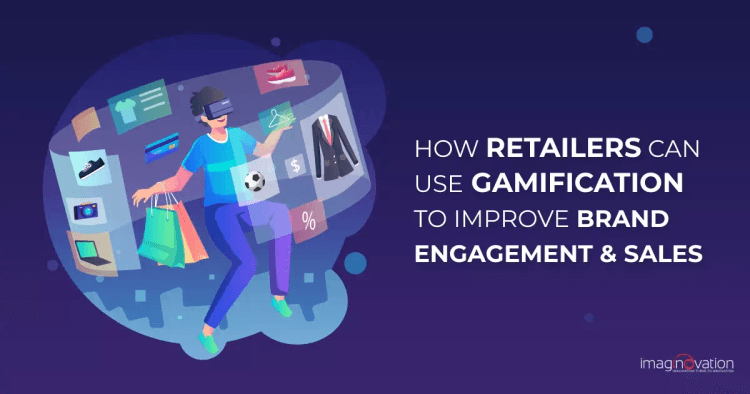Is your retail business in need of exciting new ways to attract customers?
If so, consider gamification.
Gamification works well in retail because when you gamify your retail process, you engage your customers in a fun and interactive way, driving them to shop more.
Moreover, game mechanics make your customers feel like they're earning something every time they shop, increasing the likelihood that they'll return to your store.
On top of that, gamification creates an experience for your customers that goes beyond a mere transaction.
In this article, we'll explore how you can successfully implement gamification strategies in your retail business. We'll also look at examples of brands that have used gaming elements to enhance their customers' shopping experiences.
Gamification in Retail: An Overview
Gamification can be applied to nearly anything, but one of the most impactful areas is retail.
Let’s start with the question: What is gamification?
Gamification is the application of game elements and principles to non-game contexts. It “gamifies” experiences that aren’t traditionally considered games by tapping into the natural human impulse to achieve, be rewarded, and stay engaged.
Gamification in retail feels natural: searching for a product can be like a treasure hunt, reading reviews is like getting tips from other players, using a discount code is like leveling up with points you’ve earned, and leaving reviews lets you guide others on what’s good or not.
Retail gamification can happen both in-store and online.
It has the power to surprise and delight customers, creating lasting relationships between brands and consumers.
An excellent example of gamification in action is Starbucks' reward program. You earn stars when you buy a drink, and you can redeem these stars for rewards like free drinks or other prizes.
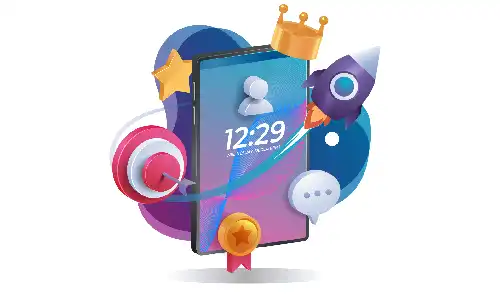
Retail and gamification: A look at the statistics
- The demand for gamified systems will continue to increase, growing from 9.1 billion USD in 2020 to 30.7 billion USD by 2025 at a compound annual growth rate (CAGR) of 27.4%. (Source)
- Retail leads the way in adopting gamified solutions, holding a 28.6% market share. Education follows closely as the second-most popular sector.
- Gaming aspects have been shown to increase customer acquisitions by as much as 700%. (Source)
- Gamification tactics can raise engagement and loyalty by 30%, according to a study of brands, including Walgreens, eBay, Threadless, and more.
In the highly competitive retail sector, gamified experiences will make you stand out from the crowd.
It can effectively engage customers, foster relationships, and boost sales. A game-like system can be used to reward your consumers or employees in a way that makes them naturally want to engage with your service.
Gamification marketing is all about making your customers happy. To do this, you can offer them small gestures of goodwill, like discounts, priority brooches, vouchers, and loyalty points. These gestures make customers feel valued and appreciated, boosting your sales.
Also Read: Top 7 Industries That Can Benefit The Most From A Gamified Application
How to Successfully Implement Gamification Strategies in Retail
Gamification has worked its way into different aspects of our lives. Now it's time to bring gamification into retail — and we must do it right.
Remember that your main goal here is not to create a popular game, like Candy Crush or Angry Birds, but to increase customer engagement and retention and build loyalty.
You need to ensure you're following the most relevant gamification strategies to succeed in this endeavor. Here we go:
1. Consider the big picture
When trying to gamify something, it's essential to avoid getting caught up in too many details. Gamification is, by its nature, a broad concept that can be applied to just about anything.
So, no matter what you're trying to gamify, it's essential to keep in mind that you'll need to approach it with a long-term view.
Gamification is, after all, all about long-term engagement; it's not just about creating an initial buzz.
Therefore, while some people will be more competitive than others, you’d want to gamify to engage as many people as possible. So pay attention to which approaches work best, and make adjustments as needed.
The key to that is figuring out what will resonate with your audience and what won't.
Don't overcomplicate things -- keep it simple and fun!
2. Augment your game elements with technologies like AR/VR
Augmented reality brings life to your game elements and brings customers a more interactive experience.
If possible, you can experiment with AR tech and get a promising result.
For example, Macy's Magic Fitting Room is an augmented reality mirror that allows customers to try on outfits in various colors to see how they look. The mirror also assesses sizes and recommends products in the stock of the right size for the customer.
3. Don’t just celebrate the top performer; recognize other contributions
When measuring performance, look for ways to reward all participants regardless of their final standing.
Remember, all participants were fully engaged in your program, which is a huge win. Isn’t it?
It's essential to reward top performers, but don't forget to celebrate other participants as well. They'll likely disengage from your program if they feel like they're not getting rewarded.
After all, gamification in business is about engaging everyone!
4. Remember to gamify product recommendations
Product searching can be overwhelming for customers.
Keep in mind to make product search fun and easy for shoppers by introducing games to the process.
Add quizzes to guide your customers to the products best suited to their needs. For example, Sephora, the cosmetics retailer, does this by including quizzes on its site that help shoppers determine which products are best for them.
Quizzes can also help you target your audience and narrow your focus for increased conversions.
You can also use surveys, such as the "Find out your type" ones. These will help your customers with product selection, promotion, and gathering vital customer data. They are helpful nonetheless for improving the overall shopping experience on your app/website.
You can also include a treasure hunt game on your eCommerce website to direct customers to specific pages.
5. Display visual progress at checkout
This is another simple gamification activity that all online stores should implement.
It's as simple as adding a progress bar or other micro-interaction to the online payment process so that customers clearly see how far they have reached in completing their purchase and how many steps are left to go.
This can help retain those customers who might otherwise abandon their carts before completing a purchase.
6. Make sure rewards aren't overemphasized
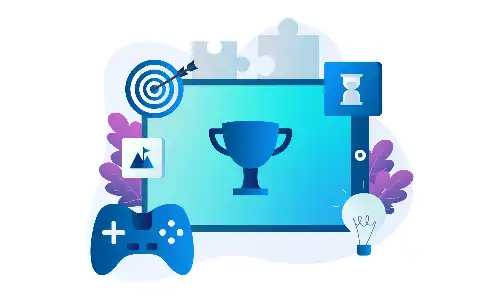
There is a misguided belief that people will only participate in your program if the rewards are big and flashy.
This is a fallacy because the best corporate gamification programs are about competition, not rewards.
The problem with relying too much on big rewards is that you'll find it challenging to keep funding for them in the long run. Moreover, it creates false incentives.
7. Bring fun to referral programs and attract new customers
If you want your customers to be your brand advocates, offering referral programs is smart.
In simple terms, referral programs ensure the user gets a discount for each ‘friend’ they bring to the online store. The user also receives a discount if they leave a comment or review on the website or specialized platform.
These gamified referral programs can create a sense of urgency in your users, spurring them to spread the word and earn rewards.
Besides, if you make the process fun, your customers are more likely to engage with your program and share it with others.
And this means more word of mouth for you!
Spin-the-wheel games, for example, are the latest craze, and many businesses are happily setting up spinning games and rewarding customers with discounts, free shipping, prizes, and more.
Badges can also be used in a variety of ways within your referral program to keep customers engaged and encourage them to reach their goals.
8. Bring creativity to your rewards
Some rewards are more effective than others.
So, you need to be as creative as possible.
For example, gift certificates and iPads can be huge motivators. But not everybody responds well to them.
Sometimes a little recognition from management goes a long way. For example, lunch with the CEO is a no-cost prize that connects the gamification back to the business as a whole.
9. Add an element of challenge to the game
Challenge is another powerful tool in gamified applications.
As a motive, they encourage customers to take the expected action.
Add an element of challenge that is usually tailored-made and direct customers depending on the context. It also helps you refine where you want your customers to go and how you want them to get there.
Also Read: Why Businesses Should Care About Gamification: A Statistical Perspective
5 Excellent Retail Gamification Examples
Many retail brands use gamification to inject fun into their marketing campaigns and feedback systems. This improves their customer experience and also increases brand visibility.
They use poll quizzes, trivia games, spinning wheels, puzzles, and AR marketing to do this.
Here are some examples of retailers who’ve successfully implemented gamification into their business models.
1. Sephora, a leading beauty brand, gamifies its customer experience
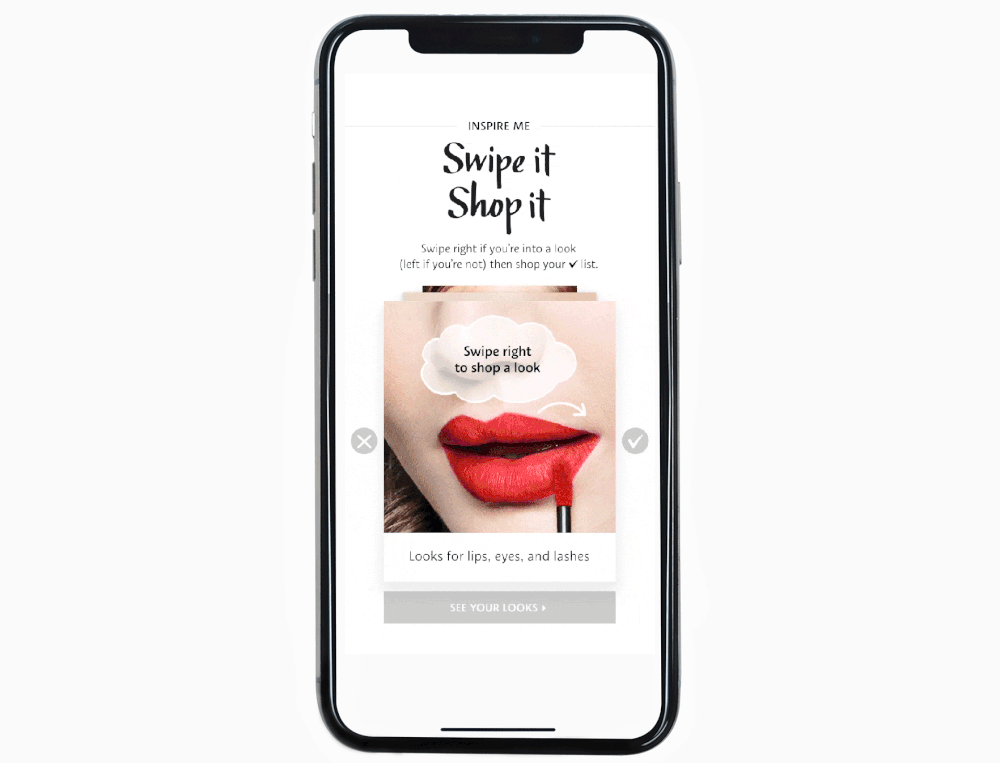
Sephora gamified the daunting task of choosing between hundreds of beauty products by creating an innovative marketing campaign called “Swipe it. Shop it.”
The company found inspiration in the user-friendly and familiar interface of the Tinder dating app, which allows customers to swipe left or right depending on whether or not they like a specific look.
Sephora also found that gamifying its product catalog with this campaign could reduce the anxiety of browsing an endless array of products and make it an enjoyable experience for its shoppers.
Besides, Tinder-inspired gaming elements on their site helped them attract the millennial audience.
Sephora's reward system is another example of gamification in action. Here, customers earn redeemable points, badges, and other rewards for buying from Sephora.
2. eBay, the online marketplace, gamifies to build user engagement
eBay's bidding system is a brilliant example of retail gamification that drives more transactions by pitting users against one another and delivering an exciting customer interaction.
eBay gives auction winners a serious high by adding a competitive element to the online auction process and encouraging users to bid against one another. That motivates them to keep coming back for more and increase their time spent on the site.
eBay also gets to collect more user information through account signups.
To get you bidding, the online auction site has gamified the act of buying a product. This means that you have to place a bid to win an item instead of just buying it outright.
This has led to a culture of outbidding other customers, finding elusive and rare items for a good price.
3. Casper, a mattress company, uses gamification for brand awareness
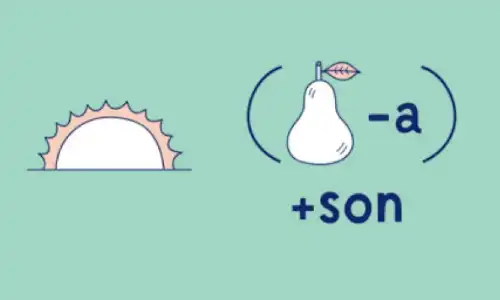
Casper, a mattress company, found an exciting way to build brand awareness. They placed ads in the New York subway with riddles that led to their website. The answers were all connected to the brand's topic of a good night's rest.
This example of gamification is brilliantly simple and works by arousing curiosity.
This way, Casper turned a brand awareness advertisement into a fun and simple game that provided a welcome distraction from the mental stress of the NYC commute.
The puzzles were short enough to solve in the time spent on the subway but complicated enough to make you think. The best thing about these riddles was that they covered the entire car on both sides.
Cleverly, Casper designed this campaign by encouraging consumers to visit their website for solutions.
4. Gilt Groupe has a gamified VIP loyalty program.
The Gilt Groupe is a website for online shopping and selling. It offers limited-time sales that can only be accessed by members. It features products from a select group of brands.
In late 2009, Gilt launched a new category for its most loyal customers: Noir. To qualify for Noir membership, you must be in the top 1% of Gilt shoppers based on the total value of past purchases and the membership duration.
Each member gets a scented candle, a member's card, and special early access privileges to preview all product sales.
Though they can only buy items after other Gilt members, the early access privilege of Members-Only participants enables them to survey the sale products 15 minutes earlier than others. This gives them an edge over fellow bargain hunters by allowing them to identify what items will likely be sold out soon and strategize how they'll beat the competition to these coveted items.
5. Teleflora, the floral service, gamified its entire store
Teleflora's gamification effort has been a success.
The company awarded points to its customers for many user actions, including customer reviews, comments, responses to other customer queries, and posts on Facebook.
If an individual offered the first review of a product or answered a question in the user Q&A section, they would receive additional bonus points.
As users continued to accumulate points, they would be rewarded with higher-level badges and titles, such as "influencer ."Top performers were even listed on Teleflora's leaderboard.
The results were impressive, with a 105% increase in Facebook referrals and a 10-fold increase in the number of pictures and videos uploaded. In addition to this, Teleflora's conversion rate improved by 92%.
Gamify Your Retail Business App With Imaginovation
As gamification increasingly becomes a cornerstone of marketing strategies, more businesses are exploring ways to leverage this technology. Since the shopping experience has remained relatively unchanged, retailers are now seeking innovative methods to captivate consumers, especially when there's nothing particularly unique to draw them in.
Whether you're running an online business or a physical retail store, having a gamified app can keep customers coming back for more.
So, why not build your retail app today?
Gamify your retail app with Imaginovation – We can help you engage customers through fun and enticing challenges, boosting loyalty and rewarding repeat purchases.
Contact us to learn how we can help make your retail business more engaging and fun for customers.
Imaginovation is an award-winning web and mobile app development agency with vast experience in crafting remarkable digital success stories for diverse companies. Let's talk.
Ready to build an app, but not sure where to start?
We've got you covered. Click the button below to get started.

